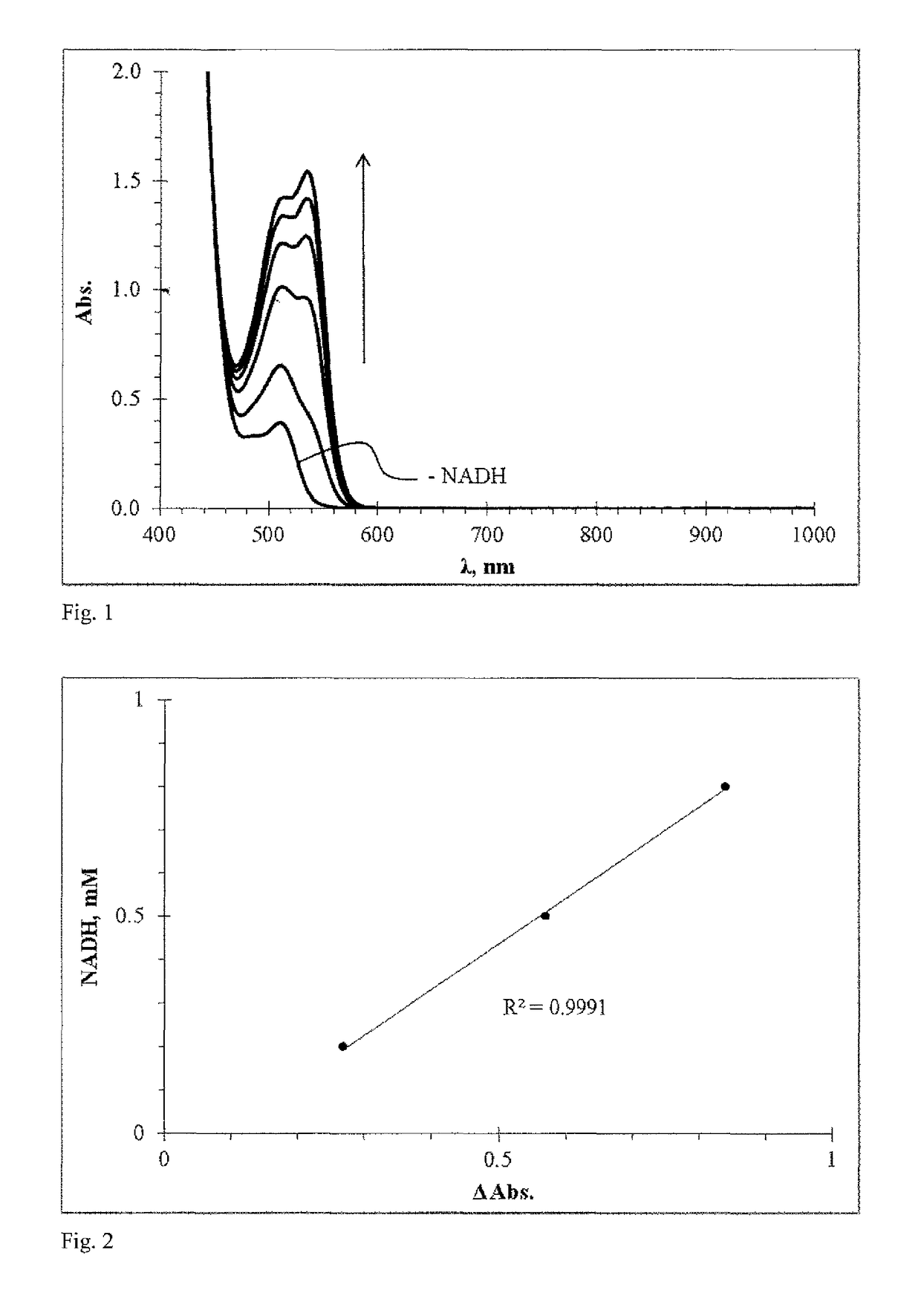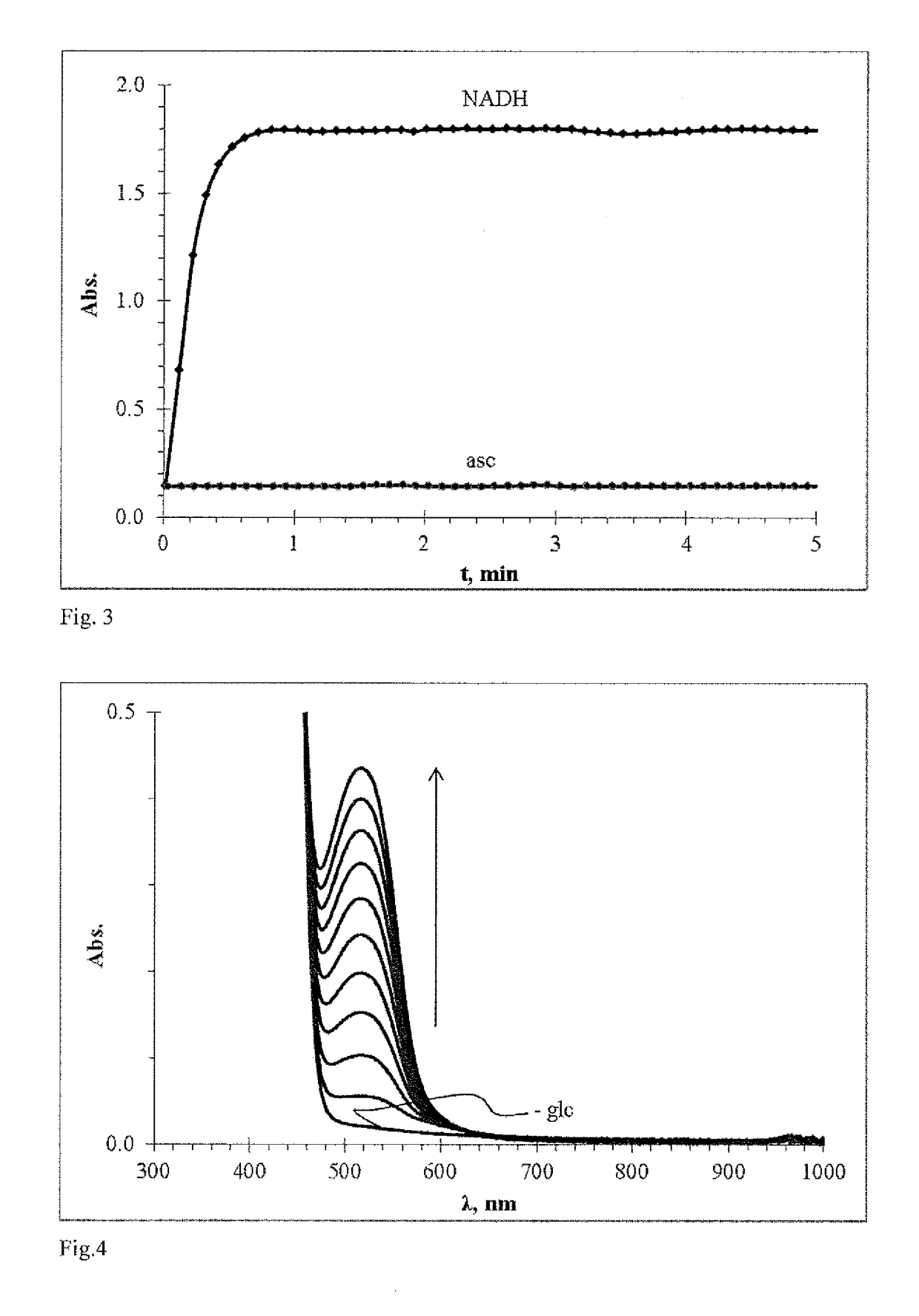Redoxindicators
a technology of redox states and indicators, applied in the field of redox states, can solve the problems of low extinction coefficient of the reduced form of these compounds, compounds are not very stable, and the redox states are not very well defined
- Summary
- Abstract
- Description
- Claims
- Application Information
AI Technical Summary
Benefits of technology
Problems solved by technology
Method used
Image
Examples
example 1
1-Methyl-6-((E)-3-oxo-3-phenyl-propenyl)-quinolinium methosulfate (MOPPQ)
1.1 Synthesis
1.1.1 Synthesis, Step 1: Synthesis of (E)-1-phenyl-3-quinolin-6-yl-propenone (XIV)
[0139]
[0140]To a solution of 6-Quinolinecarbaldehyde (XXXIII) (500 mg, 3.18 mmol) in 50.0 ml EtOH and 6.40 ml NaOH (10% in H2O) Acctophenone (XXXIV) (0.371 ml, 3.18 mmol) was added. The mixture was stirred at room temperature for 16 h and subsequently concentrated under reduced pressure. The remaining crude product was purified by silica gel chromatography (n-hexane / acetone; 75:25) obtaining 117.4 mg (14%) of the title compound.
1.1.2. Synthesis, Step 2: Synthesis of 1-methyl-6-((E)-3-oxo-3-phenyl-propenyl)-quinolinium methosulfate (MOPPQ, (XXII))
[0141]
[0142]To a solution of (E)-1-phenyl-3-quinolin-6-yl-propenone (XXXV) (80.0 mg, 0.309 mmol) in 3.00 ml acetone dimethylsulfate (0.587 ml, 6.17 mmol) was added. The mixture was stirred 16 h at room temperature. The obtained suspension was filtered and the remaining precipi...
example 2
9-ethoxyphenazine-1-carbaldehyde
2.1 Synthesis, Step 1: Synthesis of (9-ethoxyphenazin-1-yl)methanol
[0144]
[0145]A suspension of 9-ethoxyphenazine-1-carboxylic acid (XXXVI) (1.50 g, 5.59 mmol) (synthesized from N-(2,6-difluorophenyl)-3-nitroanthranilic acid by a method in Rewcastle, G. W.; Denny, W. A. Synth. Commun. 1987, 17, 1171) in DMF (15 mL) was treated with 1,1′-carbonyldiimidazole (CDI) (1.85 g, 11.40 mmol), and the mixture was stirred at 50° C. for 1 h. After cooling, the mixture was diluted with DCM / petroleum ether (1:1) to complete precipitation of the imidazolide, which was collected, washed with petroleum ether, dried, dissolved in THF (200 mL) then slowly added to a solution of NaBH4 in H2O (50 mL). After stirring for 1 h, the mixture was neutralized by dropwise addition of concd HCl and then extracted with EtOAc. The organic layer was washed with aqueous Na2CO3, water, dried (Na2SO4), and evaporated, to give (9-ethoxyphenazin-1-yl)methanol (XXXVII) (1.20 g).
[0146]1H NMR...
example 3
Synthesis of 2-[(E)-2-(9-ethoxyphenazin-1-yl)vinyl]-1,3,3-trimethyl-3H-indolium iodide (XL)
[0154]
[0155]A mixture of 9-ethoxyphenazine-1-carbaldehyde (XXXVIII) (120 mg, 0.40 mmol) and 1,2,3,3-tetramethyl-3H-indolium iodide (XXXIX) (99 mg, 0.33 mmol) in ethanol (10 ml) was heated to reflux under an argon atmosphere for 3 h in the presence of piperidine (10 μL, 0.10 mmol). The reaction mixture was allowed to cool slowly to room temperature, and a red precipitate was filtered off, washed with cold ethanol, then with diethyl ether and dried. 120 mg, red powder was obtained.
[0156]1H NMR (DMSO-d6, 500 MHz): δ [ppm]=9.58 (d, J=16.7 Hz, 1H), 8.94 (d, J=6.9 Hz, 1H), 8.49 (d, J=8.5 Hz, 1H), 8.48 (d, J=16.7 Hz, 1H), 8.19 (dd, J=8.4, 7.4 Hz, 1H), 7.93-8.02 (m, 3H), 7.85 (d, J=8.5 Hz, 1H), 7.64-7.76 (m, 2H), 7.40 (d, J=7.6 Hz, 1H), 4.41 (q, J=6.8 Hz, 2H), 4.28 (s, 3H), 1.96 (s, 6H), 1.62 (t, J=6.9 Hz, 3H)
[0157]13C NMR (DMSO-d6, 101 MHz): δ [ppm]=182.0, 154.1, 147.3, 144.0, 143.7, 142.6, 141.9, 13...
PUM
| Property | Measurement | Unit |
|---|---|---|
| temperature | aaaaa | aaaaa |
| wavelength | aaaaa | aaaaa |
| molecular mass | aaaaa | aaaaa |
Abstract
Description
Claims
Application Information
 Login to View More
Login to View More - R&D
- Intellectual Property
- Life Sciences
- Materials
- Tech Scout
- Unparalleled Data Quality
- Higher Quality Content
- 60% Fewer Hallucinations
Browse by: Latest US Patents, China's latest patents, Technical Efficacy Thesaurus, Application Domain, Technology Topic, Popular Technical Reports.
© 2025 PatSnap. All rights reserved.Legal|Privacy policy|Modern Slavery Act Transparency Statement|Sitemap|About US| Contact US: help@patsnap.com



